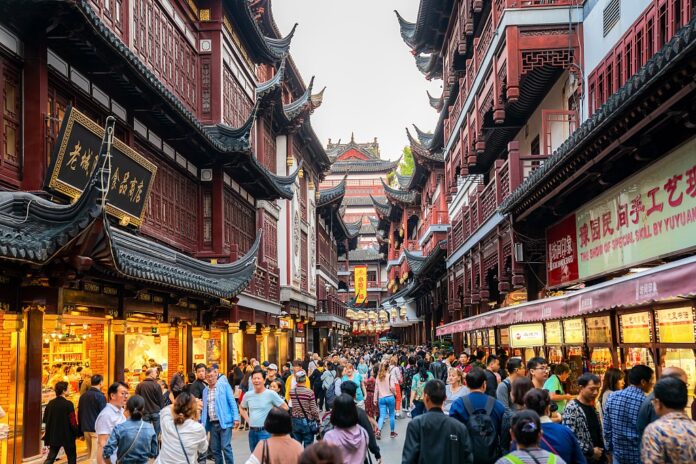
Editor’s note: CGTN has documented the transformative journey of China’s path to modernization on its special webpage, “Chinese Modernization: World Opportunities.” This article offers a peek into this unique journey outlining the profound global impact and possibilities emanating from China’s vision of shared prosperity and progress. Abhishek G Bhaya is a senior journalist and international affairs commentator. The article reflects the author’s opinions and not necessarily the views of CGTN.
Chinese President Xi Jinping once remarked that Chinese modernization is “both the most difficult and the greatest” task in the history owing to the colossal challenge posed by the Asian country’s massive population.
The Chinese leader is certainly not off the mark. In the grand landscape of global development, Chinese modernization indeed stands as a monumental and unprecedented undertaking. With a population exceeding 1.4 billion, greater than the combined populace of developed nations, China’s pursuit of modernization is an expansive endeavor that not only shapes the destiny of a nation but has far-reaching implications for the entire world.
Navigating the complexities of modernization with such a massive population is an intricate dance. Diverse demands for development emerge from a populace engaged in solving challenges ranging from employment and distribution to education, healthcare, housing, and social care. China acknowledges that the key to success lies in forging consensus and promoting inclusive development.
Despite becoming the world’s second-largest economy, China continues to grapple with imbalances and is the first to recognize these disparities. The per capita Gross Domestic Product (GDP) ranks lower than 80th globally, emphasizing the need for inclusive growth. Urban-rural disparities persist, reflecting the vast regional differences within the country. The sheer scale of China’s population presents challenges never encountered in human history, making its modernization a pioneering effort, moving “from zero to one.”
Inspiring impact: A global game-changer
Chinese modernization is not just a national ambition; it’s a transformative force with immense global significance. President Xi Jinping rightly asserts that China’s modernization will rewrite the international landscape.
The sheer scale of China’s modernization endeavors will reshape the international landscape. Unlike high-income countries that represent a mere 15.8 percent of the world’s population, China’s population constitutes 18 percent of the world, and its successful modernization would double the global modernized population, marking an unparalleled achievement in human history.
China’s unique path challenges the notion that modernization equals Westernization. With over 80 percent of the world’s population residing in developing countries, China presents an alternative model, rooted in its own national conditions. It champions inclusive development, demonstrated through growth strategies and practices focussed at “allowing some to get rich first and then helping others get rich.”
Also, China’s modernization opens doors to global opportunities. Over the past four decades, China has lifted over 800 million people out of poverty, expanded the middle-income group to over 400 million, and become the main trading partner for over 140 countries. Its huge population continues to fuel global economic growth, attracting foreign investment and fostering international trade.
Chinese path follows a holistic approach

China’s modernization efforts emphasize the need for continual reform and innovation. The path chosen by China is not merely about achieving efficiency; it is about maintaining a higher degree of social equity. The modernization journey is the modernization of common prosperity for all, an essential contribution to global development.
The Chinese path to modernization extends beyond economic growth. Emphasizing a holistic approach that integrates material and cultural-ethical advancements, this vision encompasses the development of a great modern socialist country. The Chinese route seeks to harmonize material abundance with cultural enrichment, underlining the importance of humanism and humane values as foundational elements of modernization.
While recognizing the potential risks and challenges, the Chinese leadership’s unwavering commitment to a peaceful development path stands as a testament to China’s dedication to a harmonious world order. The Chinese path to modernization prioritizes independence, self-reliance, and mutually beneficial cooperation, fostering a spirit of win-win collaboration in a rapidly changing global landscape.
China’s people-centered governance concept, resonating in the belief that “the country is the people, and the people are the country,” underlines the commitment to prosperity for everyone, leaving no one behind. China’s triumph in eradicating absolute poverty and building a moderately prosperous society underscores the feasibility and success of the Chinese path to modernization.
A driving force for global growth and development

The global impact of Chinese modernization reverberates across various dimensions.
Economically, China’s modernization serves as a robust catalyst for global economic recovery. Its huge market space, combined with abundant human resources, provides a formidable impetus to the world economy. China’s role as a major trading partner, substantial direct investor worldwide, and a magnet for foreign businesses positions it as a key player in shaping the global economic landscape.
The Belt and Road Initiative (BRI) and the Global Development Initiative (GDI) exemplify China’s commitment to common development. With over 75 percent of countries worldwide and 32 international organizations participating in the BRI, it has become a driving force for international investment and job creation. The GDI, supported by over 100 countries and numerous international organizations, contributes significantly to achieving the UN Sustainable Development Goals for 2030.
Culturally and ethically, China envisions a harmonious coexistence of diverse civilizations. President Xi’s Global Civilization Initiative (GCI) emphasizes the respect for the diversity of civilizations, promoting mutual learning, dialogue, and inclusiveness. China actively engages with the international community to foster enhanced exchanges, understanding among different peoples, and the integration of diversified cultures, creating a vibrant tapestry of world civilizations.
Environmental stewardship is integral to Chinese modernization, with an emphasis on harmony between humanity and nature. Leading initiatives in afforestation, renewable energy development, and commitment to climate change mitigation, China positions itself as a global leader in building a clean and beautiful world.
China’s commitment to peaceful development resonates through the Global Security Initiative (GSI), advocating a win-win approach to address security challenges. The GSI emphasizes solidarity and mutual cooperation, steering global development toward a future marked by peace, justice, and progress.
A pioneering mission for humanity

Chinese modernization, under the sagacious leadership of President Xi Jinping, represents a transformative force with profound and far-reaching global implications. China’s colossal population, instead of being a hindrance, becomes a beacon of opportunity for the world.
In the mosaic of global progress, China’s modernization isn’t just a national agenda; it’s a story of shared opportunities and collective growth and well-being of humanity. As China surges ahead, it extends an invitation to the world to join hands in shaping a future where prosperity, equity, and environmental consciousness converge.
The vision encapsulated in Chinese modernization isn’t confined to borders; it is a blueprint for a world where the challenges of today become the stepping stones for a better tomorrow, offering the world new opportunities and unveiling new possibilities for progress.
(If you want to contribute and have specific expertise, please contact us at [email protected]. Follow @thouse_opinionson Twitter to discover the latest commentaries in the CGTN Opinion Section.)









